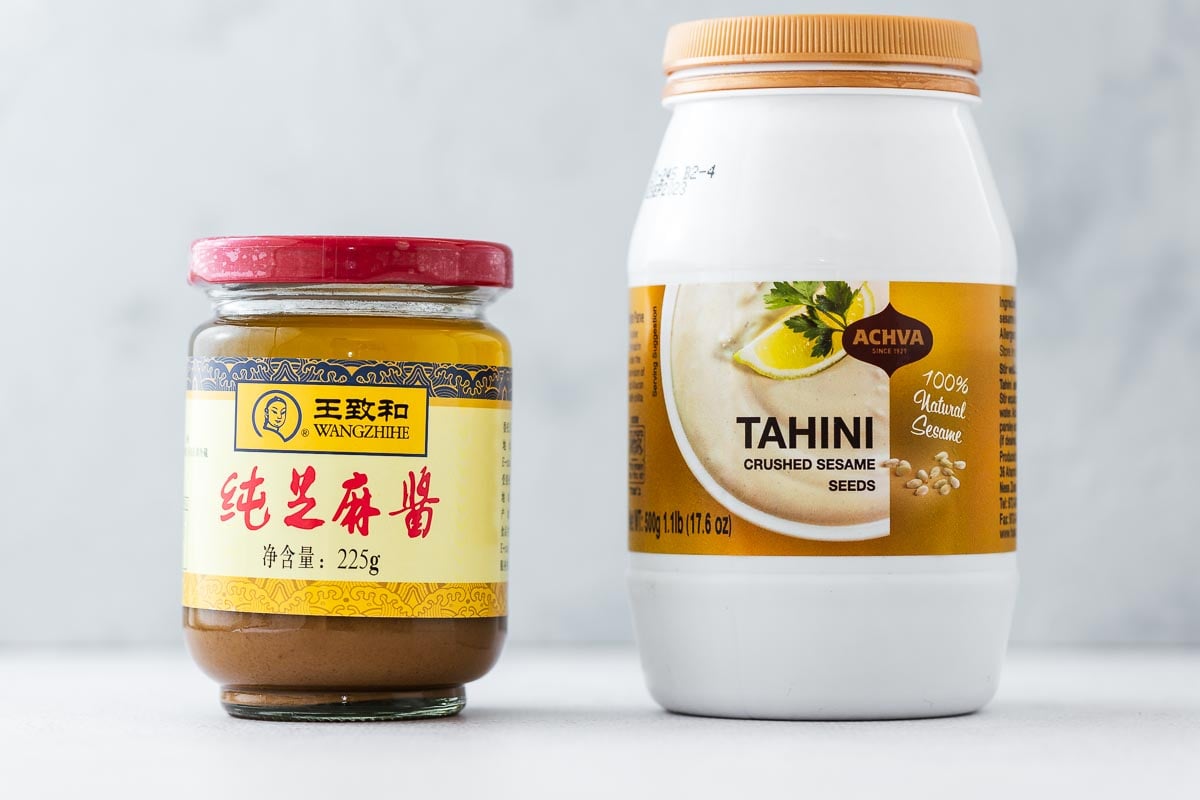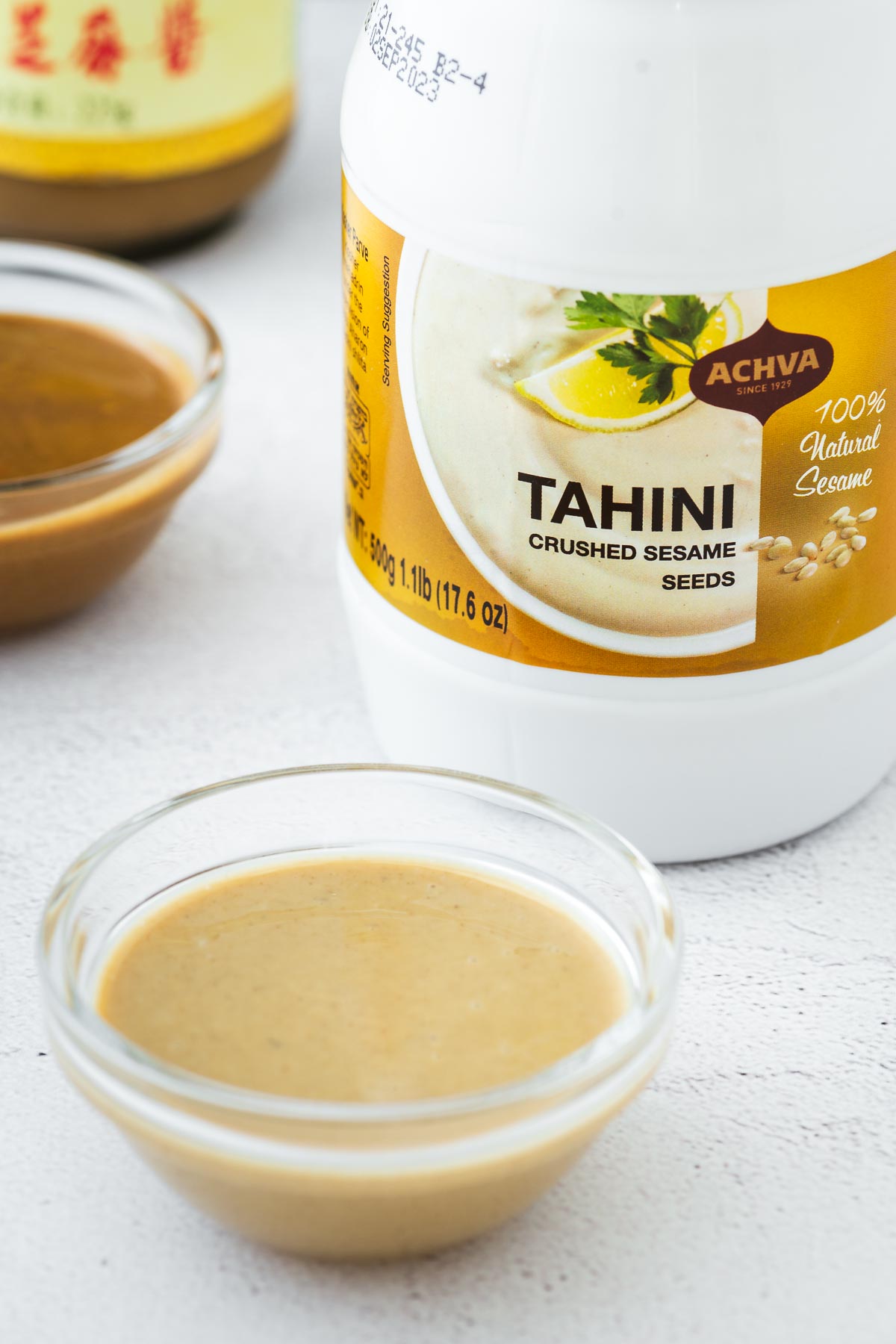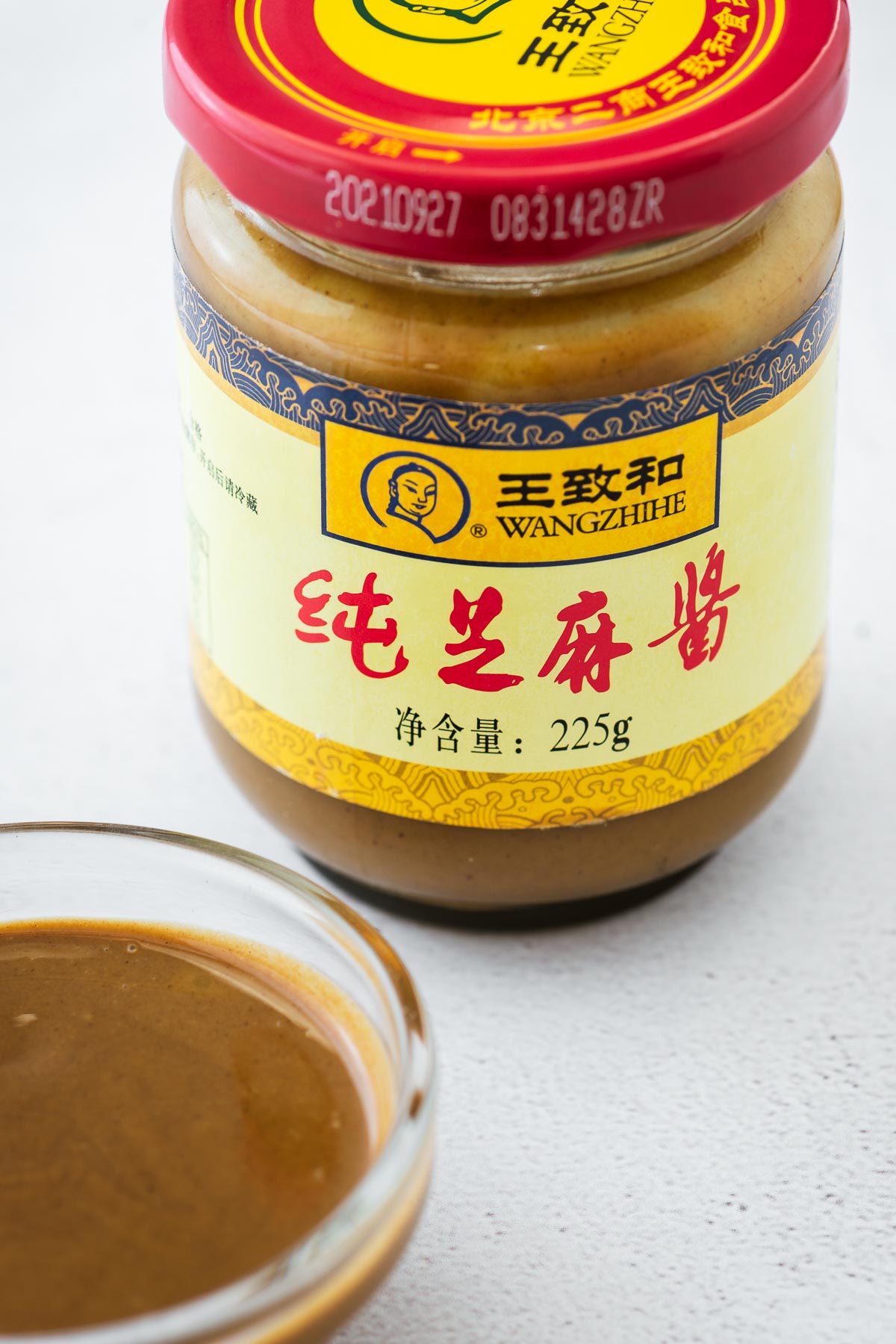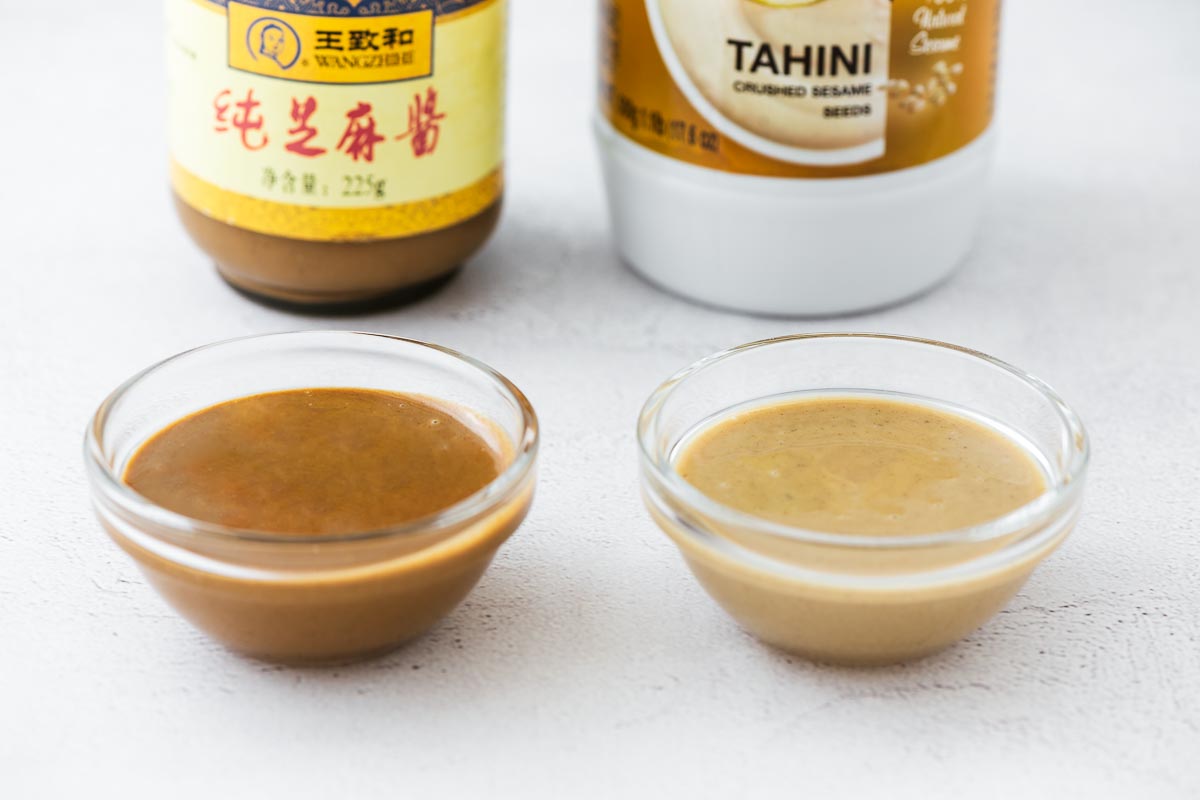Sesame Paste vs Tahini: What’s the Difference?
Sesame paste and tahini are both ground sesame pastes. Yet tahini has a light blonde colour and mild sesame flavour, whereas Chinese sesame paste is dark brown and intensely nutty. What makes tahini so different from sesame paste?
Sesame paste and tahini both consist of ground sesame seeds.
The biggest difference is that tahini contains lightly toasted hulled seeds. Whereas sesame paste uses unhulled dark toasted sesame seeds resulting in a much nuttier flavour and darker colour.
Unhulled white sesame seeds that still have their hull (or skin) intact are darker brown than the common light-coloured hulled sesame seeds.

Tahini
Tahini (tahina or tahin) is a condiment made from lightly toasted, hulled white sesame seeds. For traditional Middle Eastern tahini, sesame seeds roast on a large stone bed fuelled by a wood-fired furnace.
The toasted seeds get ground into a delicious smooth paste.
It is hugely popular in Middle Eastern cuisine and is a key ingredient in Levantine mezze, especially the well-known hummus and baba ghanoush.
Tahini paste has a deliciously mild nutty flavour. But some shop-bought tahini can have a slightly bitter taste.

How to make tahini
Make homemade tahini paste by lightly toasting raw sesame seeds and crushing them into a thick paste.
Blitz the seeds in a food processor or high-powered blender until smooth. Or, if you have the necessary arm strength and patience, use a mortar and pestle for small batches of tahini. The resulting paste should have a creamy consistency – not at all grainy.
Use untoasted sesame oil, olive oil or another neutral oil, to help the paste turn smooth and creamy. Add one tablespoon of oil at a time with the blender or food processor running.
Learn how to make tahini with detailed step-by-step instructions. And you can make black tahini with black sesame seeds.
Related post: How to make tahini paste
How to use tahini paste
Tahini is best known for its use in Middle Eastern cuisine, especially the popular Levantine dips, baba ghanoush and hummus.
But tahini is a versatile condiment for baking, dips and salad dressings.
Try these tahini recipes:
- Hummus: This Middle Eastern dip needs no introduction. This lemony hummus recipe (without garlic) is velvety smooth and loaded with tahini.
- Tahini herb sauce: Blitz fresh green herbs with tahini, lemon juice, green chilli and salt for a delicious green tahini herb sauce. Serve it as a dip or salad dressing, like in this bulgur wheat salad with tahini herb dressing.
- Tahini falafel sauce: This easy vegan lemon tahini sauce is the ultimate falafel sauce. Or serve it as a dip for fresh crudités.
- Maple tahini dressing: Try a sweet and tangy maple tahini dressing for your next kale salad.
- Tahini and bean dip: Hummus may need no introduction, but you can also make delicious tahini and bean dips using jarred white beans. Even better, blitz your leftover beans into white bean hummus with tahini.
- Tahini granola: This delicious tahini granola with sesame, honey and orange sings with Middle Eastern sesame flavours.
The best substitute for tahini
Tahini has a blonde colour, mild flavour and high fat content. Pick a nut or seed butter with similar qualities.
Cashew butter is the best tahini substitute with the closest colour match and buttery, slightly nutty flavour. Tahini has a thick and creamy, yet pourable, consistency. If your cashew butter is too thick, add some untoasted sesame oil (or any neutral oil) and stir well to combine.
Almond butter or seed butter (like sunflower seed butter) also works well as a substitute for tahini.
Sesame paste
Sesame paste is a common ingredient in Asian cuisines. It is similar to tahini in its production but not as similar in taste.
Chinese sesame paste often contains unhulled sesame seeds. And the tiny seeds get toasted until dark brown.
It results in an equally rich and creamy texture but has a much darker colour and nuttier flavour. The taste is similar to dark roasted peanut butter with skins.
Chinese sesame paste, or neri goma in Japanese, is a popular ingredient in Chinese and Japanese cuisine. It is also common in Indian sweet dishes.
Black sesame paste is another variety of sesame seed paste. It contains black sesame seeds. And the taste is very similar to Chinese sesame paste, but it has a dramatic deep, black colour.

How to make Chinese sesame paste
For the best homemade Chinese sesame paste, use unhulled sesame seeds. You can look for unhulled sesame seeds at health food stores. But hulled sesame seeds will also work.
Follow the same steps for making tahini, but ensure that your unhulled sesame seeds roast until they are dark and nutty but not burnt.
Blend it until you get a smooth paste with a lusciously creamy texture.
If your blender or food processor is not strong enough, your paste may develop a grainy texture. Add toasted sesame oil to your running food processor, one tablespoon at a time, until you have a creamy texture. (Never add toasted sesame oil to tahini paste.)
Related post: How to make tahini paste
The best substitute for Chinese sesame paste
Natural peanut butter is the best substitute for Chinese sesame paste. It has a similar taste and texture, especially with dark roasted peanut butter blended with skins.
And Chinese sesame paste is an excellent substitute for peanut butter and nut butter if you have a peanut allergy (or other nut allergies).
While pure sesame paste is nut-free, you should always check the label for possible cross-contamination warnings if you have food allergies.
How to use sesame paste
Chinese sesame paste is an ingredient in dan dan noodles, specifically the American Chinese version of the noodle dish. But it is a versatile condiment that adds flavour to Asian dressings, dipping sauces and noodle dishes.
Use it instead of peanut butter in spicy satay sauce, gado-gado and Asian salad dressings.
It also forms the base of goma dare, the Japanese dipping sauce that accompanies shabu-shabu, a hot pot dish popular in Japanese cuisine.
Try this Japanese sesame sauce recipe and use it in cold noodle dishes, as a dipping sauce or drizzled over steamed vegetables.
Questions
Where to buy tahini?
When it comes to store-bought tahini, you want to look for authentic tahini from the Levant region (like Lebanon or Isreal).
Tahini should have only sesame seeds as an ingredient.
Try your local grocery store or shops that specialise in Middle Eastern imports. My local grocery store keeps their best tahini in the Kosher aisle.
But, if you struggle to find authentic tahini in the grocery store, you can try it online. The one I buy most often is Achva organic tahini, but there are many options.
If you struggle to find good quality tahini, you can make homemade tahini from hulled white sesame seeds.
Where to buy Chinese sesame paste?
Sesame paste is available in the Asian aisle of large grocery stores or in speciality Asian supermarkets.
You can also buy Chinese sesame paste online. The most common brand, the one I also buy, is Wangzhihe Pure Sesame Paste.
Is sesame paste gluten-free?
Yes, pure sesame paste and authentic tahini are both gluten-free. Both should only contain sesame seeds.
But always check the product label for possible cross-contamination warnings.

Sesame paste vs tahini summary
Tahini is a white sesame paste with a blonde colour and mild sesame taste. Chinese sesame paste is darker in colour with an intense nutty flavour similar to dark roasted peanuts.
Sesame paste is associated with Asian cuisine, specifically Japanese and Chinese cuisine. It is a well-known ingredient in American Chinese dan dan noodles and goma dare, the Japanese sesame dipping sauce.
Tahini paste is a popular condiment in Middle Eastern cuisine, especially in the Levant region. It gives classic hummus its creamy texture and earthy flavour, as with baba ghanoush.
Both sesame pastes are lusciously creamy, versatile condiments that deserve a spot in your pantry.
Try sesame paste in this Japanese sesame sauce recipe.
Or make your own tahini at home to use in the creamiest hummus (without garlic) or a delicious green tahini sauce to drizzle over grain salads like this bulgur wheat salad.
